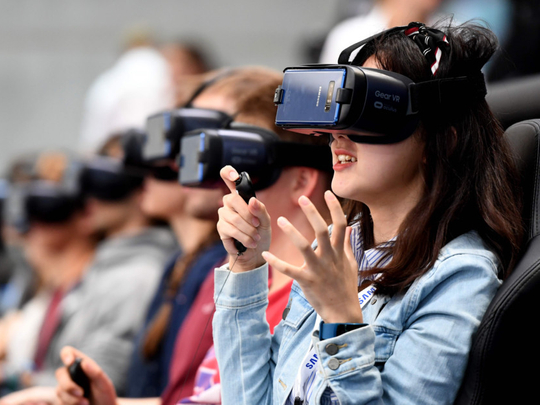
Dubai: The virtual reality (VR) market has been experiencing significant growth with increasing numbers of content launches, consumer and enterprise deployments in entertainment, retail, marketing, and other segments.
As the VR adoption rate increases, so does the expectation and requirements of VR head-mounted displays (HMDs).
As VR makers continue to improve the level of immersion, ABI Research forecasts that VR HMDs with six DoF (six degrees of freedom refers to the freedom of movement of a rigid body in three-dimensional space) will represent over 40 per cent of combined mobile and stand-alone VR market in 2022.
To meet user expectations, VR HMDs have a long way to go in many features including display quality, DoF, and connectivity. The majority of VR HMDs currently available in the market support only 1080/2K resolution displays — which need to be greatly improved to solve the screen door effect caused by low resolution displays.
New tethered devices with 4K display such as Aukey Cortex and Pimax and the arrival of mobile headsets with 4K display are likely to drive the penetration of high-resolution VR devices.
Khin Sandi Lynn, industry analyst at ABI Research, said that accuracy in tracking movements is another important feature for an immersive VR experience. Most of the current VR devices support only three DoF tracking, meaning movement in the three dimensions but not rotation, with the exception of tethered devices, which are usually targeted for high-end market support six DoF.
“A six DoF is the ideal goal and mobile and stand-alone VR devices are moving towards six DoF tracking to provide a total immersive experience. Mindmaze and uSens have announced six DoF position tracking solution for mobile VR devices, and Google announced Worldsense, a stand-alone VR device with six DoF,” she said.
Angela McIntyre, research director at Gartner, said that HMDs account for only seven per cent of all wearable devices shipped in 2017, and will not reach mainstream adoption with consumers or industrial customers through 2021.
“Current low adoption by mainstream consumers shows that the market is still in its infancy, not that it lacks longer-term potential. Near-term opportunities for virtual reality HMDs among consumers are with video game players,” she said.
Moreover, she said that workers will also use them for tasks such as equipment repair, inspections and maintenance, but also in warehouses and manufacturing, training, design, customer interactions and more.
“Theme parks, theatres, museums and sports venues will purchase HMDs to enhance the customers’ experience in interactive attractions or movies, and add information and supplemental images at sporting events,” she said.
In terms of connectivity, 802.11 n/ac WiFi is supported by mobile and stand-alone devices.
While tethered devices are still connected to a PC or console with a cable, however, a wireless connection is likely to replace the cable connection. “For tethered VR and high-resolution VR content, 60 GHz (WiGig) will play important role to support high bandwidth in the years to come. WiGig will be mainly deployed in the tethered VR devices which need multi-gigabit connectivity with low latency. Nearly 40 per cent of VR HMDs are expected to support WiGig connectivity in 2022,” she said.










